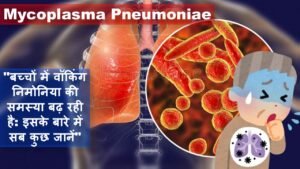mycoplasma pneumoniae
“बच्चों में वॉकिंग निमोनिया की समस्या बढ़ रही है: इसके बारे में सब कुछ जानें”
माइकोप्लाज़्मा निमोनिया के प्रभाव
अगर आपको या आपके बच्चे को खांसी है जो लगातार बनी रहती है, तो इस जानकारी पर ध्यान दें। रोग नियंत्रण और रोकथाम केंद्र (सीडीसी) के अनुसार, यू.एस. में माइकोप्लाज़्मा निमोनिया के मामले तेज़ी से बढ़ रहे हैं, खासकर छोटे बच्चों में।
डलास में यूटी साउथवेस्टर्न और चिल्ड्रन हेल्थ में बाल रोग विशेषज्ञ डॉ. प्रीति शर्मा इस वृद्धि पर बारीकी से नज़र रख रही हैं। मई के अंत में, उनकी 12 वर्षीय बेटी को स्कूल से घर आने पर हल्की सर्दी जैसे लक्षण महसूस होने लगे- नाक बहना, छींक आना, गले में हल्का दर्द, थकान और भूख न लगना।
फिर उसकी खांसी बिगड़ गई और बहुत गहरी, लंबे समय तक चलने वाली और परेशान करने वाली हो गई। इसी खांसी ने उन्हें बताया कि उनकी बेटी को माइकोप्लाज़्मा निमोनिया है, जो माइकोप्लाज़्मा निमोनिया नामक जीवाणु के संक्रमण के कारण होता है। सीडीसी के अनुसार, इस साल वसंत और गर्मियों के दौरान यू.एस. में मामलों में वृद्धि हुई है, और यह वृद्धि जारी है। डलास में स्कूलों के फिर से खुलने के बाद यह वृद्धि देखी गई है।
डॉ. शर्मा का कहना है कि बच्चे स्कूलों में एक-दूसरे को संक्रमित कर रहे हैं और यह संक्रमण उनके माता-पिता और परिवार के अन्य सदस्यों तक भी पहुँच रहा है।
माइकोप्लाज्मा निमोनिया के लक्षण
माइकोप्लाज्मा निमोनिया से संक्रमित बच्चों में आमतौर पर ऊपरी श्वसन संबंधी लक्षण होते हैं, हालांकि कुछ मामलों में उनकी आँखें लाल हो सकती हैं या शरीर पर चकत्ते हो सकते हैं। सिरदर्द भी एक सामान्य लक्षण है। वाशिंगटन, डी.सी. के चिल्ड्रन नेशनल हॉस्पिटल के बाल रोग विशेषज्ञ डॉ. कैलेब वार्ड का कहना है कि हालांकि मामले अधिक हैं, लेकिन अधिकांश हल्के हैं, इसलिए इसे अक्सर ‘वॉकिंग निमोनिया’ कहा जाता है।
न्यूयॉर्क शहर में भी ऐसे मामलों में वृद्धि देखी जा रही है। न्यूयॉर्क विश्वविद्यालय और हैसेनफेल्ड चिल्ड्रन हॉस्पिटल के बाल रोग विशेषज्ञ डॉ. एडम रैटनर का कहना है कि सभी उम्र के लोग इससे प्रभावित हो सकते हैं, हालांकि संक्रमण आमतौर पर 5 से 17 वर्ष की आयु के बच्चों और किशोरों में अधिक होता है। लेकिन इस बार, छोटे बच्चों (2-4 वर्ष) में भी मामले बढ़ रहे हैं।
Mycoplasma Pneumoniae
उपचार और सावधानियाँ
डॉ. शर्मा, डॉ. वार्ड और डॉ. रैटनर के अनुसार, ज़्यादातर बच्चों का इलाज घर पर ही किया जा सकता है—उन्हें हाइड्रेटेड रखें, बुखार के लिए उम्र के हिसाब से दवाएँ दें और उन्हें आराम करने दें। एक साल से ज़्यादा उम्र के बच्चों को शहद देने से उनकी खांसी कम हो सकती है।
अगर बच्चे को सांस लेने में दिक्कत हो रही है, वह पर्याप्त तरल पदार्थ नहीं पी रहा है, सामान्य से ज़्यादा सुस्त लग रहा है या 5 दिनों से ज़्यादा बुखार से पीड़ित है, तो उसे डॉक्टर को दिखाना चाहिए।
माइकोप्लाज्मा निमोनिया का इलाज एंटीबायोटिक दवाओं से किया जा सकता है, लेकिन सही एंटीबायोटिक (जैसे एज़िथ्रोमाइसिन) लेना ज़रूरी है क्योंकि आम एंटीबायोटिक एमोक्सिसिलिन प्रभावी नहीं है। अपने बच्चे को स्कूल तभी भेजें जब उसे कम से कम 24 घंटे तक बुखार न हो और वह शारीरिक रूप से ठीक महसूस करे।
खांसी और नाक बहने जैसे लक्षण हफ़्तों तक रह सकते हैं और इस दौरान भी बच्चे में संक्रमण फैलने की संभावना बनी रहती है। डॉक्टरों का मानना है कि यही वजह है कि माइकोप्लाज्मा निमोनिया का प्रकोप लंबे समय तक रह सकता है।
सावधानी बरतें
सर्दियों के मौसम में, जब वायरस फैल सकता है, तो बच्चों और खुद को बार-बार हाथ धोने और खांसते या छींकते समय अपना मुंह ढकने की याद दिलाना ज़रूरी है।
Mycoplasma Pneumoniae
*मायकोप्लाज्मा न्यूमोनिए* एक प्रकार का बैक्टीरिया है जो इंसानों में हल्के से लेकर मध्यम स्तर तक के श्वसन संक्रमण का कारण बनता है, जिसे आमतौर पर *मायकोप्लाज्मा न्यूमोनिया* कहते हैं। इस संक्रमण को कभी-कभी “वॉकिंग न्यूमोनिया” भी कहा जाता है, क्योंकि इसके लक्षण आमतौर पर हल्के होते हैं और व्यक्ति सामान्य जीवन जी सकता है।
### मायकोप्लाज्मा न्यूमोनिए के लक्षण:
इस संक्रमण के लक्षण धीरे-धीरे शुरू होते हैं और इसमें शामिल हो सकते हैं:
1. **लगातार खांसी** – गहरी और लंबे समय तक चलने वाली।
2. **गले में खराश**।
3. **सिरदर्द** और **थकान**।
4. **नाक बहना** या **जकड़न**।
5. कुछ मामलों में, **आंखों में लालिमा** और **त्वचा पर चकत्ते** भी हो सकते हैं।
यह बीमारी अधिकतर बच्चों और किशोरों (5-17 वर्ष) में देखने को मिलती है, लेकिन छोटे बच्चे भी संक्रमित हो सकते हैं।
### संक्रमण का कारण:
*मायकोप्लाज्मा न्यूमोनिए* बैक्टीरिया के संपर्क में आने से यह संक्रमण होता है। यह संक्रमित व्यक्ति की खांसी या छींक से फैल सकता है, जिससे स्कूलों और घरों में एक से दूसरे व्यक्ति में संक्रमण फैलना आम है।
इलाज और सावधानियाँ:
– मायकोप्लाज्मा न्यूमोनिया के इलाज में एंटीबायोटिक दवाएँ दी जाती हैं, जैसे *एज़िथ्रोमाइसिन* या *डॉकसीसाइक्लिन*, क्योंकि *एमोक्सिसिलिन* इस पर प्रभावी नहीं होती।
– बच्चों को अधिक मात्रा में पानी पिलाएँ, उन्हें आराम दें, और बुखार के लिए आयु-उपयुक्त दवाइयाँ दें।
– खांसी से आराम पाने के लिए एक साल से अधिक उम्र के बच्चों को शहद देने से भी मदद मिल सकती है।
### बचाव के उपाय:
– खांसते या छींकते समय मुँह और नाक ढकना।
– बार-बार हाथ धोना, खासकर भीड़भाड़ वाली जगहों से लौटने के बाद।
मायकोप्लाज्मा न्यूमोनिया के लक्षण हफ्तों तक रह सकते हैं, इसलिए संक्रमित व्यक्ति को सावधानी बरतनी चाहिए ताकि संक्रमण आगे न फैले।

“Walking pneumonia on the rise in children: Learn all about it”
The effects of Mycoplasma pneumonia
If you or your child has a cough that has persisted, pay attention to this information. According to the Centers for Disease Control and Prevention (CDC), cases of Mycoplasma pneumonia are increasing rapidly in the U.S., especially in young children.
Dr. Preeti Sharma, a pediatrician at UT Southwestern and Children’s Health in Dallas, has been watching this increase closely. In late May, her 12-year-old daughter started experiencing mild cold-like symptoms when she got home from school—runny nose, sneezing, mild sore throat, fatigue and loss of appetite.
Then her cough worsened and became very deep, long-lasting and bothersome. It was this cough that tipped her off that her daughter had Mycoplasma pneumonia, caused by infection with the bacterium Mycoplasma pneumoniae. According to the CDC, cases have increased in the US during the spring and summer of this year, and this increase is continuing. This increase has been seen in Dallas after the reopening of schools.
Dr. Sharma says that children are infecting each other in schools and this infection is also reaching their parents and other family members.
Symptoms of Mycoplasma pneumonia
Children infected with Mycoplasma pneumonia usually have upper respiratory symptoms, although in some cases their eyes may turn red or there may be rashes on the body. Headache is also a common symptom. Dr. Caleb Ward, a pediatrician at Children’s National Hospital, Washington, D.C., says that although the cases are high, most are mild, so it is often called ‘walking pneumonia’.
New York City is also seeing an increase in such cases. Dr. Adam Ratner, a pediatric infectious disease specialist at New York University and Hassenfeld Children’s Hospital, says people of all ages can be affected, although the infection is usually more common in children and teens aged 5 to 17. But this time, cases are also increasing in younger children (2-4 years).
Treatment and precautions
According to Dr. Sharma, Dr. Ward and Dr. Ratner, most children can be treated at home—keep them hydrated, give age-appropriate medicines for fever and let them rest. Giving honey to children over one year of age can help ease their cough.
If the child is having difficulty breathing, is not drinking enough fluids, seems more lethargic than usual, or has been sick with a fever for more than 5 days, he or she should see a doctor.
Mycoplasma pneumonia can be treated with antibiotics, but it’s important to get the right antibiotic (such as azithromycin) because the common antibiotic amoxicillin is not effective. Send your child to school only if he or she has been fever-free for at least 24 hours without fever reducers and feels physically well.
Symptoms like cough and runny nose can last for weeks, and during this time, the child is still susceptible to spreading the infection. Doctors believe this is why Mycoplasma pneumonia outbreaks can last for a long time.
Take precautions
During the winter season, when the virus can spread, it’s important to remind children and yourself to wash their hands frequently and cover your mouth when coughing or sneezing.

